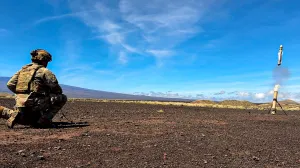Army moves to rapidly field Anduril’s Ghost-X drones via Replicator

Defense Department leadership selected Anduril-made, quiet and modular Ghost-X aerial drones to be quickly mass-produced in the second tranche of the Replicator initiative.
Sources who spoke to DefenseScoop on the condition of anonymity this week confirmed that the uncrewed system was put forward for Replicator 1.2 by the Army’s Medium Range Reconnaissance (MRR) program — and ultimately made the cut.
Replicator was largely conceptualized by Deputy Defense Secretary Kathleen Hicks and her team, who first unveiled the initiative in August 2023.
Citing security concerns, Pentagon officials have been secretive about certain aspects of the pursuit as it all comes together. But broadly, it encompasses a multifaceted effort to deter China by incentivizing and expediting industrial production capacity and the military’s adoption of next-generation warfighting technologies en masse — through replicable processes.
Tranches within the first capability focus area — known as Replicator 1.0 — are pushing weapons and assets associated with what Hicks refers to as “all-domain attritable autonomous systems” (ADA2) to counter China’s anti-access/area-denial strategy, by August 2025.
Replicator 2.0, reported first by DefenseScoop last month, will accelerate high-volume production of technologies designed to find and destroy enemy drones.
Although not everything is out in the open at this point, DefenseScoop has confirmed that the first two tranches of selections — Replicator 1.1 and 1.2 — include a mix of maritime and aerial drones and counter-drone capabilities that are being prioritized for accelerated production.
According to Anduril’s website, Ghost-X is an extended-range uncrewed aerial system that’s “designed to evolve after fielding, aligning to lessons learned from the hardware and software iteration required in contested environments like Ukraine and [U.S. Indo-Pacific Command].”
A company specification sheet states that Ghost-X deploys in minutes from a slim rifle case or tactical soft case during dismounted operations, and can be launched and recovered in confined landing zones. The drones have 80 to 90 minutes of cruise endurance, up to 15 miles operating range, capacity to carry payloads that are 25 pounds or less, and are weatherized for a range of harsh and austere environments.
They are part of Anduril’s Ghost family of systems that its CEO Palmer Luckey said he originally created to counter China’s increasing pervasiveness across the global drone industry.
Via a press release last month, Anduril announced that Ghost-X was tapped for the Army’s Company Level Small Unmanned Aircraft System (sUAS) Directed Requirement, which is meant to rapidly field “commercial capability to Brigade Combat Teams to inform requirements, doctrine, tactics, training, and maintenance concepts for the Army’s Medium Range Reconnaissance (MRR) program.”
The company thanked the Pentagon’s Defense Innovation Unit — one of the key organizations driving the execution of Replicator — in that release.
In response to questions from DefenseScoop, Hicks’ public affairs advisor Eric Pahon said on Thursday: “We have no announcements to make at this time regarding Replicator 1.2 capability selections.”
An Anduril spokesperson declined to comment or share details on Ghost-X pricing.
For fiscal 2024, Pentagon officials have secured about $500 million from Congress to fund early Replicator batches. Department leaders requested an additional $500 million to enable the project for fiscal 2025.






